Aventon Aventure 3 Review | Recapturing the Fat Tire Crown?
The newest version of Aventon’s versatile, all-terrain adventure e-bike adds a variety of security and ride customization features to an already stellar foundation.
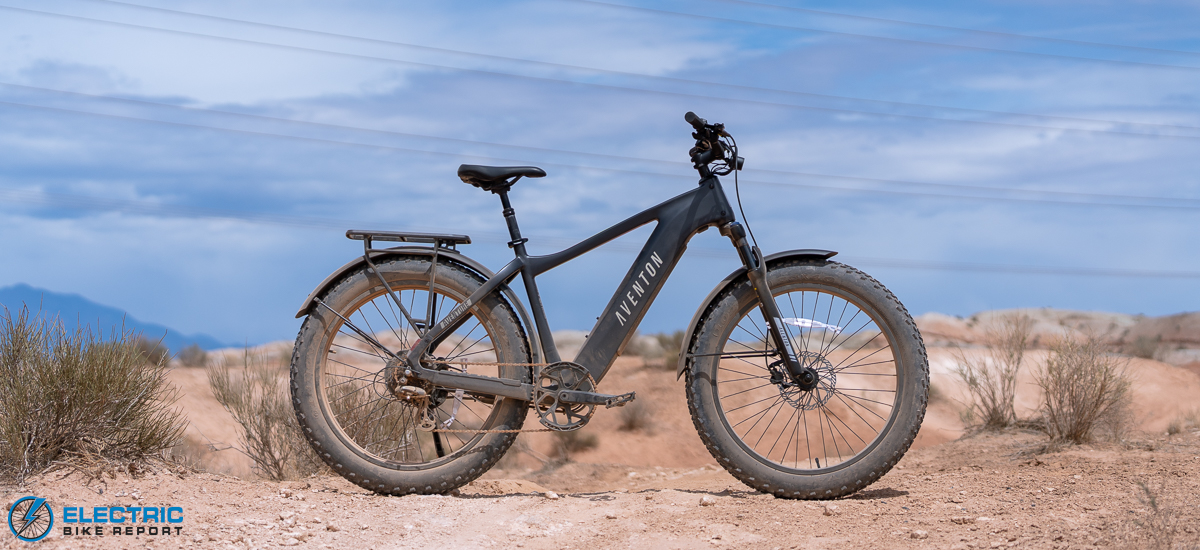
Aventon has largely raised the bar among fat-tire e-bikes with each new model in the Aventure line. The original model delivered a comfortable, capable, and stable ride with its upright geometry, powerful 750W motor, and genre-defining 4-inch-wide tires.
The second-generation bike added a torque sensor for improved responsiveness and range. Great overall performance and value additions like a color display, Bluetooth connectivity, and integrated turn signals cemented it as our go-to recommendation for the best fat-tire e-bike on the market. It also turned out to be one of the best e-bikes we’ve tested and reviewed, period.
Now, Aventon has brought the Aventure 3 to market, boasting a redesigned frame manufactured with the brand’s recently adopted method of gravity casting and equipped with its hi-tech ACU module.
The ACU is noteworthy for its integrated 4G chip, enabling owners to monitor the bike’s location via GPS tracking, limit its riding area through geofencing, and remotely deactivate it in the event of theft. The module also governs the mechanisms for a rear wheel lock and an ejectable battery, along with a motor customization feature in the Aventon app.
Based on our previous experiences with the Aventure and other new Aventon models, the Aventure 3 has been one of our most anticipated releases. We knew to expect refined geometry, improved programming, and a suite of security features, but we weren’t sure how well it would perform. After all, the competition has had a couple of years to catch up.
Did the Aventure 3 continue to build on the excellent foundation laid by its predecessors, or do we expect it to get lost in a sea of superior fat tire e-bikes? Continue reading our full review below to arrive at our verdict!
Class 2 (throttle to 20 mph)
Class 3 (pedal assist to 28 mph)
 Pros
Pros- Updated programming gives the Aventure 3 a highly responsive and natural-feeling pedal assist system. Its 750W motor can feel reserved or robust—plus its power levels can be customized!
- Along with the ACU comes security features, including GPS tracking, a motion detection/alarm system, remote disabling, etc.There’s also an optional passcode, a wheel lock, and a secure, ejectable battery.
- The Aventure excels with overall comfort. We think its relaxed and upright ride will appeal to young and aging riders alike. The new suspension seatpost was also a great included feature.
- Its motor proved capable of climbing or riding fast when desired, but we found its power levels to be approachable for new riders or those who haven’t been on a bike in years.
- With two frame sizes and styles, the bike can fit a wide range of riders from 4’11” to 6’4”.
- The Aventon app is extremely useful and user-friendly. It grants access to motor tuning and security features, along with ride and health data tracking, and a social media platform to connect Aventon owners.
- It’s equipped with useful safety features that include brake lights and turn signals.
- The bike’s clean and nearly weld-free gravity-cast frame looks better than ever. It’s available in a great selection of color options.
 Cons
Cons- Only one profile can be paired per bike, which can be inconvenient when sharing the bike. We’d like to see the ability to assign a bike to multiple users.
- Battery: Removable Internal Lithium-Ion, 36V, 19.88 Ah, 733Wh, LG 21700 cells
- Display: Aventon BC280
- Motor: 36V/750W Hub Drive (1188W Peak), 80 Nm torque
- Headlight: Integrated LED
- Taillights:Seat stay-integrated LED, with turn signals
- Pedal Assist: 3 Assist Levels with Ride Tune Capabilities
- Claimed Range: Up to 65 miles
- Throttle:Aventon LH Handlebar Mounted
- App:Aventon App
- UL Certification:UL 2271 & UL 2849 Certified
- Claimed weight: 77 lbs
- Tested Weight: 78 lbs
- Rider height range: 5’3” to 6’4”
- Total payload capacity: 400 lbs
- Brakes:Tektro HD-E3520 Hydraulic Disc Brake w/ Ej1 Quick Disconnect, 180mm rotors front and rear
- Fenders:Included
- Fork:Aventon/Zoom Suspension Fork, 80mm travel, with lockout
- Frame: Gravity Cast Aluminum Front Triangle
- Drivetrain:8-Speed Shimano Altus, 48T chainring, 12-32T cassette
- Grips: Aventon Lock-on grips
- Saddle: Aventon Saddle
- Handlebar: Aluminum 31.8, 680mm
- Kickstand: Included
- Pedals: 9/16” Alloy Platform
- Tires: Innova 26×4.0 puncture-resistant
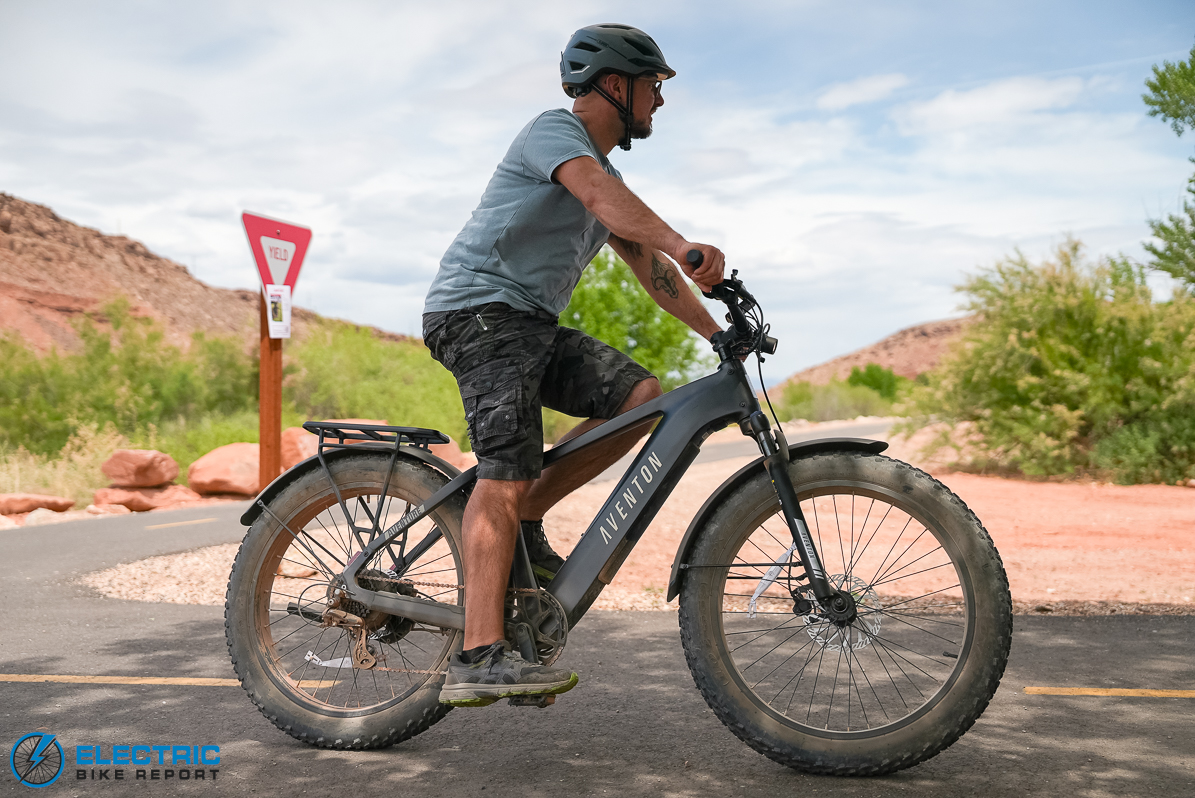
The Aventure’s ride is as sturdy and stable as ever. We liked its redesigned look and its sporty-yet-comfortable feel.
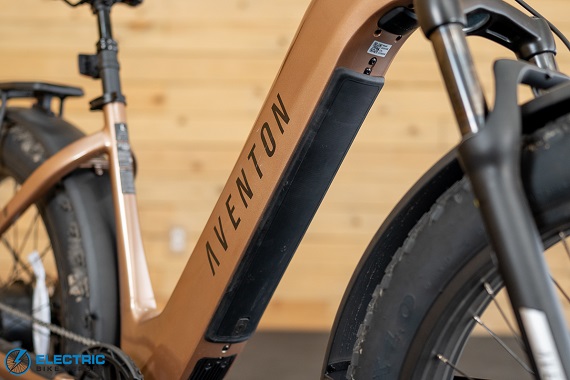
The bike’s 36V, 733-Wh battery is fully integrated and locked (until ejected) in the down tube.

A locking mechanism for the rear wheel can be set to automatically engage when the bike is powered off.
Aventon Aventure 3 Review: Model Options
Taller riders with inseams around 26” or more will likely find the high-step model more comfortable. Aventon lists it as fitting riders between 5’3” and 6’4”, with leg lengths up to 35 inches.
Meanwhile, the step-through (ST) version is more accessible for smaller riders, fitting heights from 4’11” to 6’1”.
Geometry differences are minor. Both styles are fairly upright thanks to a tighter wheelbase than most fat tire bikes, so it’s a sporty position that’s still fairly comfortable.
Aventon Aventure 3 Review: Speed Test
We test every e-bike we review to find out how fast it can be, but we also use our Speed Test to evaluate throttle acceleration and the programming and power distribution of the pedal assist system (PAS).
I performed our Speed Test on the Aventure 3 by riding it on a flat, paved path in each of its PAS settings. The bike’s maximum speed is set to 20 mph with both its throttle and PAS right out of the box, but once it is paired with the Aventon app, users can increase its pedal-assisted speed up to 28 mph. I tested it with both maximum speeds; see my results above.
The graphs show a few notable things. First, having tested every other model in Aventon’s latest generation of e-bikes, I noticed a common theme with each one. The lowest assist level (Eco mode) offered a light level of power, the highest setting (Turbo mode) cranked things up to 10, and the mid-power setting (Sport mode) fell between the two but skewed more toward the power level of Turbo.
Here, we can see that same pattern in the Class 2 test results, but if I were going only by how the bike felt, I would have guessed its power levels would have been more evenly distributed—just like the Class 3 test results.
The measured increases in speed and power shown by the Class 3 data are another point to highlight. We find this sort of pattern to be intuitive, with each higher PAS setting delivering an expected boost in the bike’s capabilities.
In the Class 2 test, however, the bike’s weight and the rolling resistance from the tires seemed to balance out Sport mode’s extra boost. Personally, I found the power level in Eco to be a bit light, so if I purchased the bike, I’d probably end up tweaking the motor output in that setting through the Aventon app, but the other settings felt great.
The ability to customize motor output through the app is a prized feature. Our test results can give you an idea of what to expect with the Aventure’s standard settings, but adjustments can and likely will change its results. With a torque sensor and the fact that you and I probably pedal a bit differently, your results will probably differ regardless.
When testing the bike’s throttle acceleration, I noted that it continues Aventon’s trend of giving riders an approachable level of power. The throttle brought me up to speed quickly and steadily without feeling overpowered or out of control—a characteristic that aging e-bikers and those who haven’t been on a bike in a while will likely find appealing.
Overall, the Aventure 3 proved to be off to a great start, but we still had quite a few things to test.

With its suspension fork and seatpost, its powerful motor, and its 4”-wide tires, the Aventure is well suited for riding on dirt or gravel roads and paths.
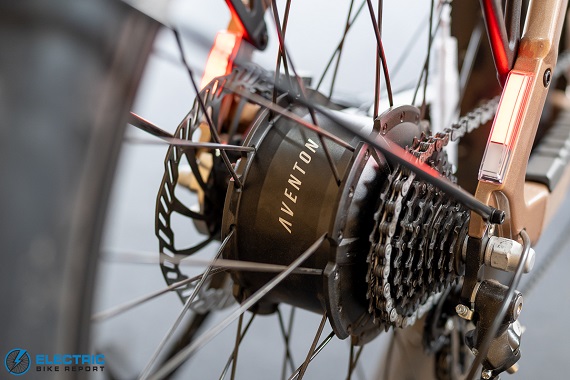
We found that the 750W motor delivered power smoothly, responsively, and naturally
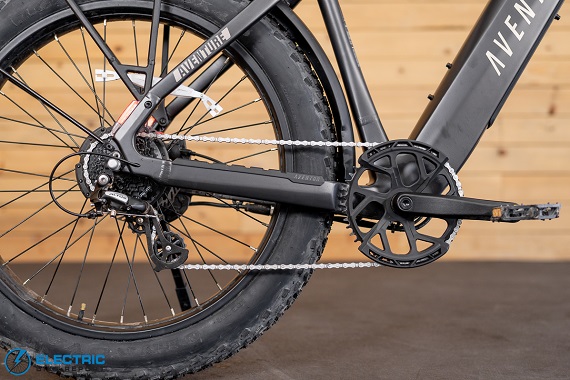
The 8-speed drivetrain is optimized for riding on flat ground or hills, as well as for low and high speeds.
Aventon Aventure 3 Review: Range Test
As with any battery-powered device, battery life is an important consideration. With e-bikes, this equates to the amount of time you can ride and the distance you can cover. The goal of our Range Test is to determine a bike’s minimum and maximum range in the real world; we used the process explained above to test the Aventure 3.
Similar bikes we’ve tested, including the best fat tire e-bikes on the market, averaged 32.1 and 60.1 miles, so the Aventure’s results lined up well with its competitors. At face value, Aventon’s range may seem relatively average—which shows it is specced appropriately—but there is one more less obvious piece to the picture to note.
The Aventure 3 uses Aventon’s almost-universal 733-watt-hour (Wh) battery, while the bikes we used for comparison had batteries that averaged a significantly larger 814 Wh. Therefore, the Aventure’s managed average results on a smaller battery with about 80 fewer watt hours—truly excellent efficiency!
To prove the Aventure’s efficiency, we can compare its Turbo mode results with an estimate based on its motor and battery specs. With a 750W motor and 733-Wh battery, we anticipated this test would last roughly 58 minutes with the bike covering about 17 miles. Its real-world results yielded an additional hour of ride time and 18 miles of range.
The bike’s Eco mode test was likely helped out by the relatively low power output I mentioned in the Speed Test section above. Riders increasing the power level of Eco mode (again, as I would likely do) should expect to get fewer miles. Additionally, we did our testing in Class 2 mode, so riders increasing the maximum speed should also expect less range.
Regardless, the Aventure 3’s results were impressive! The bike proved capable of long-distance rides, whether that means commuting to work during the week or exploring rail trails on the weekends.
Aventon advertises up to 65 miles with the Aventure 3. We were pleased with its test results, and consider our distances close enough to consider the advertised range accurate. Additionally, I was also happy to note that the bike ships with a 4-amp fast charger that should be able to recharge the battery in about 5 hours.
Aventon Aventure 3 Review: Hill Test
Fat tire e-bikes are typically some of the best at providing enough power to handle steep hills, but we tested the Aventure 3 to ensure this was still the case. As with the Range Test section above, the methods used for our test and the Aventure’s results are shown in the graphic above.
In both cases, the Aventure 3’s results were slightly above average, though within the margin of error. The pool of similar fat tire e-bikes we’ve tested averaged 1:22 in the throttle test and 1:13 when pedaling, so the Aventure’s times were 5 and 4 seconds above average, respectively.
These results make sense when considering the Aventure’s motor output and weight. Its peak of 1188W is slightly above the current category average of 1136W, while its maximum of 80 Newton meters (Nm) of torque is somewhat below the average of 87 Nm. Its motor proved effective, especially when combined with the bike’s relatively average weight of 77 lbs (technically 2 lbs below average).
Like the other new Aventon models we’ve tested, the Aventure 3 uses a 36V motor and battery, which is relatively unusual when compared with most other fat tire bikes on the market. This switch from the more common 48V systems caused a stir, as at least on paper, it makes Aventon’s e-bikes appear less powerful in comparison.
Speaking specifically about peak watts, a motor’s power is a function of both its electrical system’s voltage and its controller’s amperage. A 36V system can reach the same peak as a 48V system when combined with a higher-amp controller, but increased heat and faster degradation are legitimate concerns.
Our contact at Aventon advised us that the development team implemented changes to mitigate these concerns, including thicker wiring and a finned cover for the controller, but we still saw our Hill Test with the Aventure 3 as the true test of whether or not a 36V system could match a 48V system. As they say, the proof is in the pudding.
With results of 1:19 and 1:13 in its throttle and pedal tests, respectively, the previous model of the Aventure was two seconds slower than this bike in its throttle test and four seconds slower in its pedal test. Its motor peaked a little lower at 1130W, but with results so close, we think it’s fair to say that Aventon’s development team did their homework and their changes were successful.
Clearly, the Aventure 3 is plenty able to handle hills of both the common and relatively extreme varieties (like Hell Hole Trail). It’s powerful enough to carry you on its own if you prefer to let the motor do all the work. If you choose to pedal actively, the bike’s highest power level should allow most riders to get to the top of most hills without much exertion.
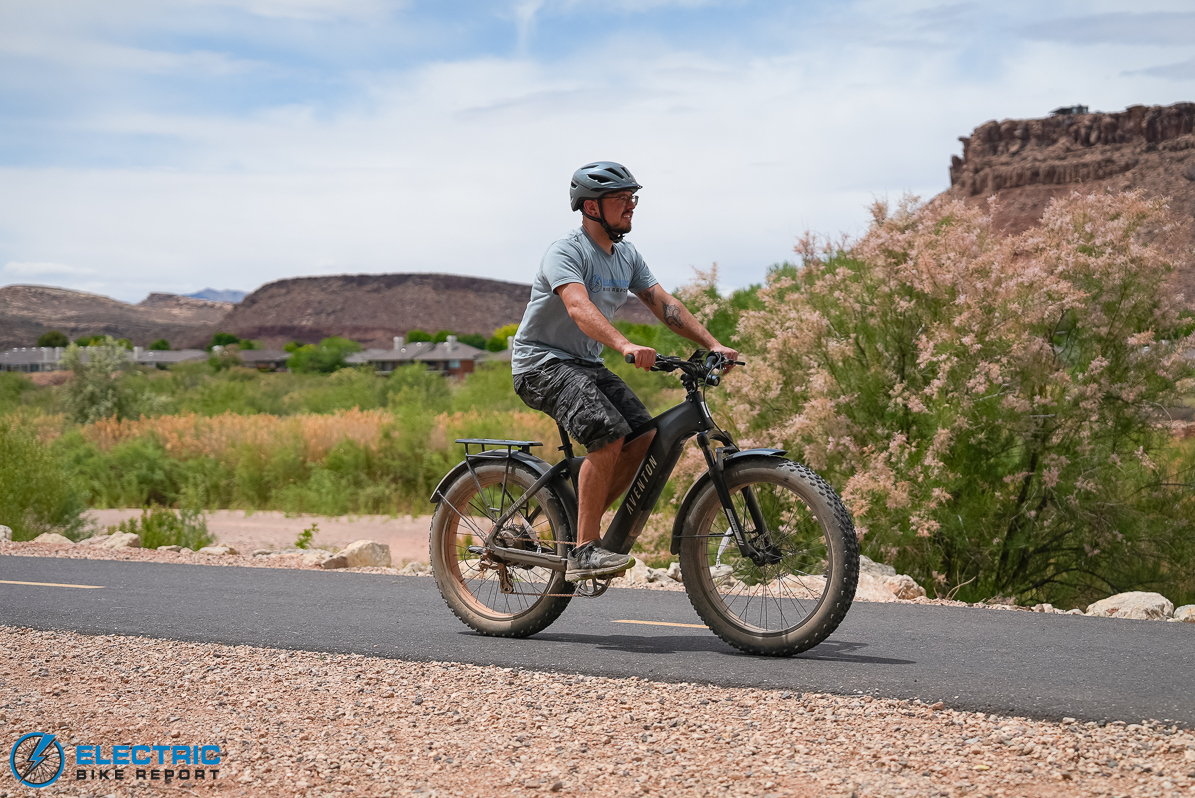
The Aventure 3 has a maximum speed of 20 mph when it arrives, but it can be adjusted to the Class 3 maximum of 28 mph through the Aventon app.
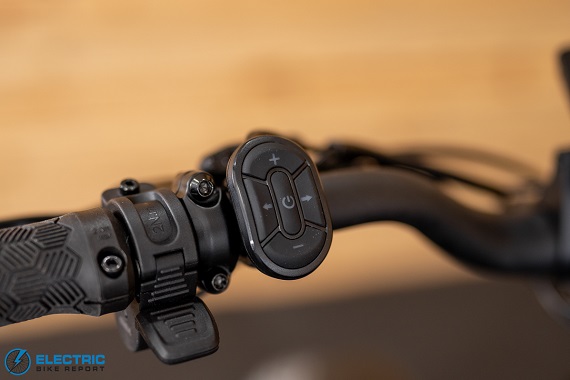
A thumb throttle lever rests on the left handlebar alongside the textured rubber grip.
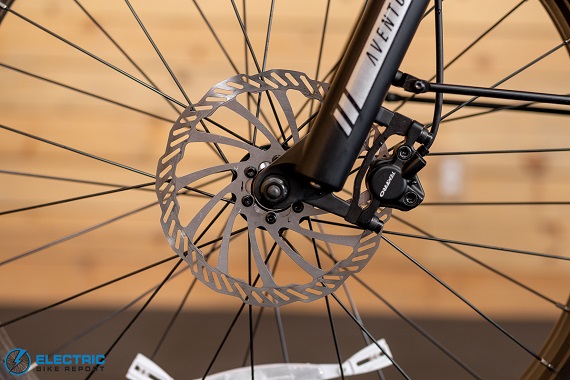
The Tektro HD-E3520 hydraulic disc brake system features 180mm rotors on both wheels.
Aventon Aventure 3 Review: Brake Test

The Aventure 3 is equipped with a familiar brake system that has appeared on many e-bikes we’ve reviewed previously: the e-bike-specific Tektro HD-E3520 hydraulic disc system. We tested its performance using the method explained above. The bike’s results were 21’6”, which is 13 inches shorter than the current fat tire category average of 22’7”.
Weight, tires, and brake specs are three major factors influencing our test results. The Aventure’s Tektro E3520 hydraulic disc brake system is extremely common on e-bikes of all styles. The bike’s 26-by-4-inch knobby tires and weight of roughly 77 lbs are relatively standard for the fat tire category, so no obvious reason stood out as to why it did so well.
In my personal testing, the brakes felt good without being too aggressive or sluggish. I’d describe their forcefulness as approachable. As our test showed, they get the job done safely and effectively, and I think their characteristics will be suitable for riders who haven’t been on a bike in a while.
All in all, the Aventure gave us solid performance, so it earns our stamp of approval.

The 680mm handlebars have a small rise for comfort and an upright riding position.
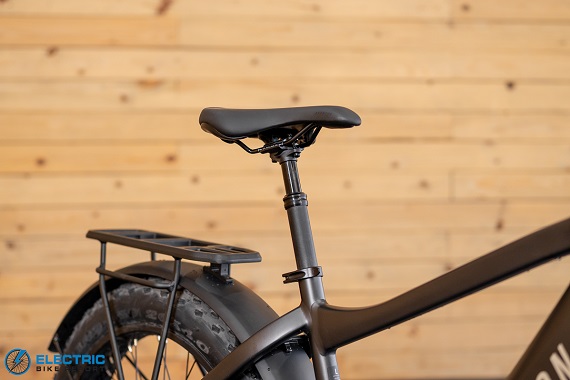
We found the suspension seatpost to be comfortable on both paved surfaces and in rougher environments.
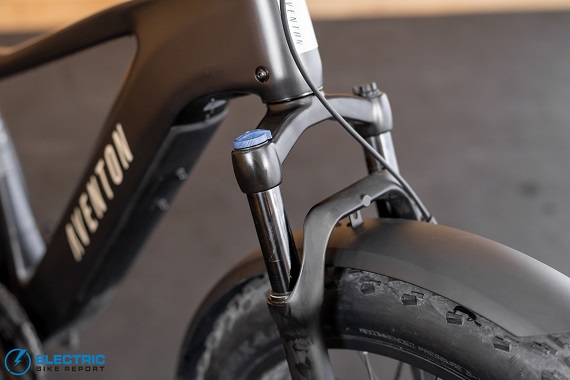
The suspension fork offers a modest but effective 80mm of travel for smoothing bumps.
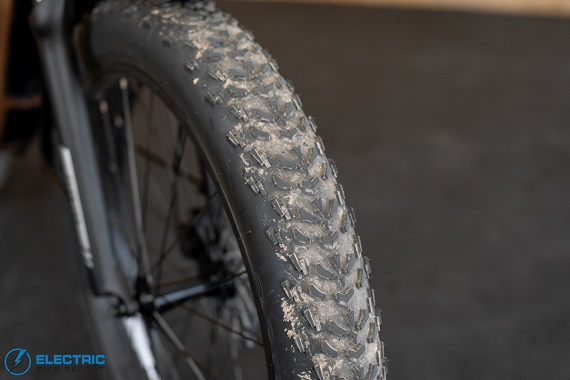
Knobby 4” fat tires provide traction on loose or rough terrain.
Aventon Aventure 3 Review: Ride Quality
Ride Quality is a summary of what a bike feels like to ride; it includes a myriad of elements from sizing and riding position to overall handling, motor engagement, and the user interface. The Aventure 3, like nearly all Aventon models at the time of writing, also includes less common elements such as the brand’s app and the ACU module’s features.
Starting with sizing, the Aventure 3 is available in two frame sizes with either a high-step (HS) or step-thru (ST) frame style. The HS model focused on in this review accommodates riders from 5’3” to 6’4”, with a split between the Regular and Large frame sizes at 5’10”. The Regular ST model fits riders from 4’11” to 5’7”, while the Large is suitable for those between 5’7” and 6’1”.
In contrast with many other fat tire e-bikes we’ve reviewed, the Aventure’s riding position is considerably upright, encouraging comfort and a strain-free experience. In my experience, it felt sporty yet relaxed, and in combination with the bike’s suspension fork and suspension seatpost, it made an hour-plus ride enjoyable and smooth.
The bike’s tires add an additional layer of comfort, particularly when riding with low air pressure. Their knobby tread gives the bike a level of versatility that largely defines the fat tire category; like most bikes of its kind, the Aventure is appropriate for on-road travel and off-road adventuring.
As part of my testing process, I rode the Aventure on gravel roads, rocky dirt roads, and dirt paths in the nearby desert. I appreciated the bike’s power, traction, and suspension, as it kept the ride comfortable while allowing me to speed over these loose and rough types of terrain; it’s well-suited for riding fire roads, multi-use trails, etc.
I found the Aventure’s handling to be surprisingly agile for a fat tire e-bike; bikes in this category are typically heavy and somewhat sluggish. The Aventure is not a light e-bike by any stretch, but it felt more lively and nimble than most similar models I’ve tested.
The bike’s motor engagement is highly responsive. When testing the bike, I noticed that it delivered power smoothly and adapted its power output almost immediately when I changed the amount of pressure I applied to the pedals. Aventon’s e-bikes have proven some of the best at combining hub motors with torque sensors; the Aventure seemed to only continue this trend.
The Aventure 3 comes equipped for commuting with integrated lights, fenders, and a cargo rack, but there are many smaller and less obvious features I appreciated. Many of the brand’s newer models eschewed tail lights that function as brake lights, but I was pleased to see this feature included, along with the bike’s turn signals and crisp color display.
A few of the bike’s main security features, such as a passcode, the rear wheel lock, and the ejection of the integrated battery, are accessible through the display’s settings menu. It’s entirely possible to make do with these features alone, and even these limited options would make the Aventure a great purchase, but the Aventon app opens up even more.
The bike’s ACU module connects to 4G networks, enabling many of the more advanced features in the Aventon app once a subscription is activated. The first year is free, but subsequent years will require a $20 annual fee or a $2/month subscription.
In addition to the location monitoring, remote disabling, and geofencing features mentioned previously, users can set up a motion detection system that can notify the owner’s phone when jostled and engage an audible (though fairly quiet) alarm when moved.
Additionally, the Aventon app grants access to the Ride Tune feature, which allows users to customize the motor’s power and the torque sensor’s sensitivity for each of its three PAS settings. I found this system of three sliders (accompanied by a helpful diagram) easy to use and intuitive.
The bike’s geofencing feature is relatively unique and ideal for situations where a bike is shared between family members, including teenagers. Once boundaries are established via GPS, the pedal assist system will deactivate (and an optional alarm can sound) if the bike exits an allowed area or enters a prohibited zone.
The app can also be used to track ride data, sync with Strava and Apple Health, interact with a community of other Aventon e-bike owners, and adjust minor settings such as the display’s brightness or the length of time it will remain on when parked.
All-in-all, these elements combined to grant the Aventure 3 an uncommonly high level of ride quality. In my experience, the bike felt sturdy, comfortable, and powerful while remaining controlled and approachable. The ACU and Aventon app added a layer of connectivity that felt high-tech and useful, especially in areas where theft may be a concern.
Aventon Aventure 3 HS vs ST Version
The differences between the high-step and step-through models are relatively minimal. The most obvious one is that color options are tied to the frame style—you can’t mix and match across models.
In terms of ride feel, both versions are quite similar. The gravity-cast aluminum construction gives the frame a stiff, responsive feel. The high-step feels a bit tighter and more nimble, while the step-through is noticeably more approachable—no need to swing a leg over, which is great for accessibility.
That said, the ST frame does have slightly more flex, which is common with any step-through fat tire bike due to the lack of a top tube.
Should that be a deterrent? Probably not. If your primary goal is rough off-road riding, the high-step will offer a bit more rigidity and control. But for general use, we found both models enjoyable to ride with solid handling characteristics all around.
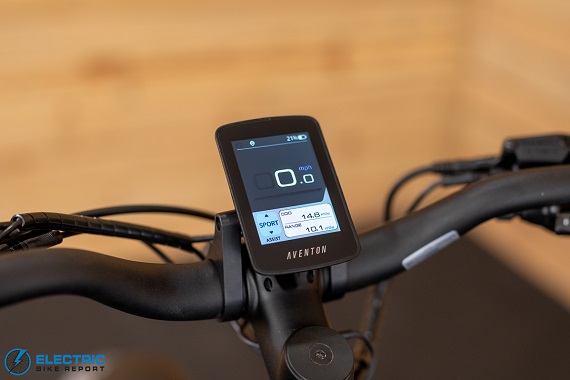
Aventon’s custom color display is clean, organized, and color-coded for easy readability.
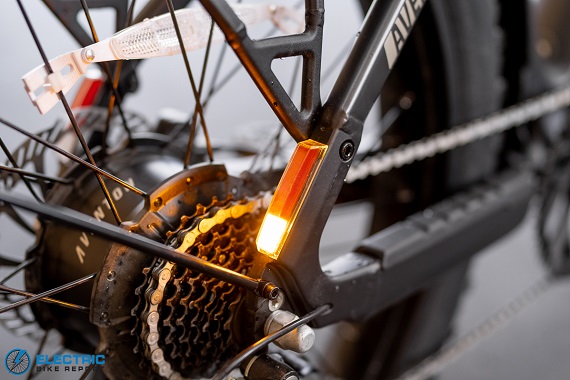
We always appreciate seeing brake lights and turn signals for increased safety on the road.
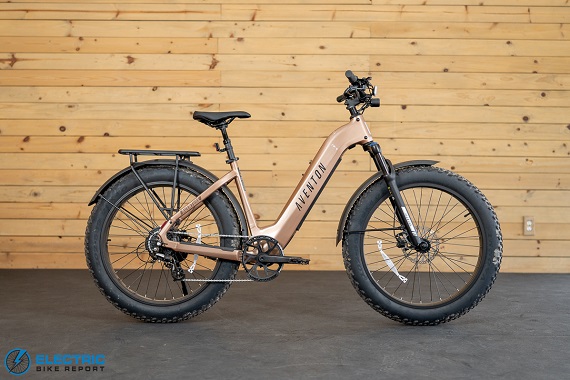
The Aventure’s ST frame has a larger gusset to help with the flex tradeoff, but it’s an easy mount at only 16” standover height, and is available in Java gold or Cobalt blue
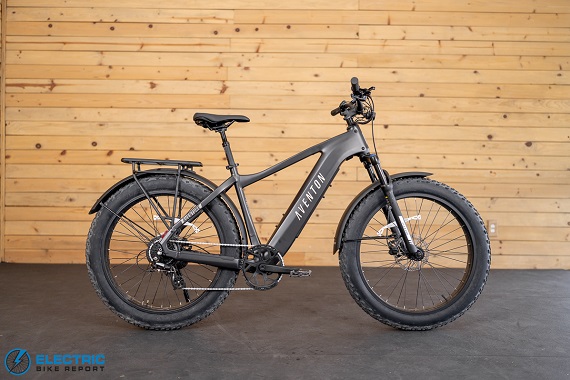
The highstep is better for those with at least a 29” inseam, and it comes in either a Matcha green or Stealth black.
Aventon Aventure 3 Review: Summary / Where to Buy
Based on my previous experiences reviewing Aventon’s other newly-redesigned and updated models, which have each differed significantly from their previous versions, I wasn’t sure if I should expect a completely different ride from the Aventure or a series of noticeable but relatively minor improvements.
The end result was something between those two extremes. Aventon didn’t reinvent the wheel with the Aventure 3, but instead, the brand added to and improved what was already a great bike.
The biggest upgrade was, of course, the ACU module and the advanced security features that come along with it. We’ve seen many similar features on a handful of other e-bikes, but in most of those cases, the other bikes were priced well above what the Aventure costs—sometimes two to three times as much or more.
As shown in the sections above, the Aventure 3 scored well in all areas of our testing. It proved to have intuitive programming with a good distribution of power and an efficient motor and battery, resulting in great range. It also demonstrated appropriate stopping power with its hydraulic brake system and solid climbing ability, thanks to its powerful and responsive motor.
The bar is generally high for most e-bikes these days, so while the Aventure’s performance on paper may appear relatively average when compared to its peers, it’s important to recognize average as great. We’re extremely pleased with where the bike landed in comparison to similar models, though its competition is fierce.
No bike is perfect, but we struggled to find a downside of the Aventure worth pointing out. I’m sure I could find a few things to tweak with more time in the saddle, but I suspect that those would largely come down to personal preference. If I had to be nitpicky, I wouldn’t mind a louder alarm system, but otherwise, I think Aventon nailed the Aventure 3.
If you identify any other areas with room for improvement, we’d love to hear your thoughts down in the comments section below this review. As it is, however, I’m happy to recommend the Aventure 3 for young or aging riders alike.
We consider the Aventure a great e-bike for aging riders who want a stable ride and enough power to handle hills. It would also be a comfortable and capable e-bike for commuting while offering the versatility for those looking to go adventuring—or should I say, Aventuring—in their off time.
Happy Riding! Make sure to let us know if you have any questions or if you think we left anything out in this review of the Aventon Aventure 3 down in our comments section.




Negatives; how about the 77 pound weight or four inch wide tires since almost nobody rides on sand or snow where they’re useful.
Both of those are likely to be positives for those who like fat tire bikes! The Aventure’s weight is relatively average for a bike of this style, and its tires provide a super stable ride even on paved surfaces. We wouldn’t say the Aventure does anything wrong in those areas.
Great review on an awesome looking bike! I saw an Ozark Trail fat tire e-bike at Walmart that is 3x less. What are your thoughts on the Ozark Trail e-bike? I’ve been debating on which one I should buy since the prices are so different.
How does this compare against the radster trail? They seem similar in my eyes, would like to know what you think. I’m stuck between these two, planning to get one!